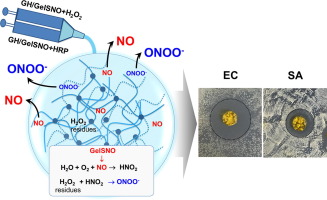Acta Biomaterialia ( IF 9.4 ) Pub Date : 2017-12-18 , DOI: 10.1016/j.actbio.2017.12.005 Thai Thanh Hoang Thi , Yunki Lee , Phuong Le Thi , Ki Dong Park

|
Nitric oxide (NO) is an endogenous molecule with many critical biological functions that depend on its concentration. At high levels, NO provides broad-spectrum antibacterial effects through both its pathogen inhibition and killing abilities. However, its short half-life has been a great challenge to its clinical application in pharmaceutical forms. In this study, we incorporated the NO donor S-nitrosothiolated gelatin (GelSNO) into injectable gelatin-based hydrogels (GHs) to controllably release NO. Under catalysis by horseradish peroxidase, H2O2 oxidizes phenol moieties functionalized on gelatin to quickly form phenol-phenol crosslinks that encapsulate GelSNO. Through thermal, visible light, and oxidizing agent-driven mechanisms, NO is released from the GH/GelSNO hydrogels. By varying the GelSNO concentration, the release of NO was controllable in a wide range, 0.054–2.050 μmol/mL, for up to 14 days. In addition, NO release was fine-tunable as a function of H2O2 concentration. Notably, the in situ formation of peroxynitrite (ONOO-) that produces potent antibacterial effects originated from H2O2 residues and nitrous acid formed by NO and oxygen in aqueous solution. The Kirby-Bauer method indicated that there was an inhibition zone against both Escherichia coli and Staphylococcus aureus incubated with GH/GelSNO hydrogels. The AlarmaBlue assay showed that E. coli and S. aureus were completely killed at NO concentrations of 0.39 and 0.58 μmol/mL. Cytotoxicity tests of GH/GelSNO hydrogels on human dermal fibroblasts at the indicated bactericidal NO concentrations induced no cell toxicity. In summary, GH/GelSNO hydrogels may provide a new platform for topical delivery of NO in treating wound infections and for various biomedical applications.
Statement of Significance
NO is an effective antibacterial agent even in cases of antibiotic-resistant bacteria. Moreover, its intermediate, peroxynitrite, has been reported to have a much higher ability to kill bacteria. In this study, we utilized injectable GH/GelSNO hydrogels formed by HRP/H2O2 reaction not only to control NO release but also to generate peroxynitrite in situ from released NO and H2O2 residues. The GH/GelSNO hydrogels showed significant antibacterial ability on both gram-positive and negative bacteria, while no cytotoxicity was induced on human dermal fibroblasts. In addition, their tunable chemico-physical properties and controllable NO release within a wide range but narrow scale will make the hydrogels useful in various biomedical applications.
中文翻译:

通过过氧亚硝酸盐的原位形成具有高抗菌活性的释放一氧化氮的可注射水凝胶
一氧化氮(NO)是一种内源性分子,具有许多取决于其浓度的关键生物学功能。在高水平下,NO通过其病原体抑制和杀灭能力提供广谱抗菌作用。但是,其半衰期短一直是其以药物形式临床应用的巨大挑战。在这项研究中,我们将NO供体S-亚硝基硫代明胶(GelSNO)掺入可注射明胶基水凝胶(GHs)中,以可控制地释放NO。在辣根过氧化物酶H 2 O 2的催化下氧化可在明胶上官能化的酚部分迅速形成封装GelSNO的酚-酚交联键。通过热,可见光和氧化剂驱动的机制,NO从GH / GelSNO水凝胶中释放出来。通过改变GelSNO的浓度,NO的释放可控制在0.054–2.050μmol/ mL的大范围内,长达14天。另外,根据H 2 O 2的浓度,NO的释放是可微调的。值得注意的是,在原位形成过氧亚硝酸盐(ONOO的- )产生有效的抗菌效果源自选自H 2 ö 2残基和亚硝酸由NO和氧气在水溶液中形成的。Kirby-Bauer方法表明存在一个针对两个区域的抑制区用GH / GelSNO水凝胶孵育大肠杆菌和金黄色葡萄球菌。AlarmaBlue分析显示,在0.39和0.58μmol/ mL的NO浓度下,大肠杆菌和金黄色葡萄球菌被完全杀死。在指定的杀菌NO浓度下,GH / GelSNO水凝胶对人皮肤成纤维细胞的细胞毒性测试未引起细胞毒性。总而言之,GH / GelSNO水凝胶可为NO的局部输送提供新的平台,以治疗伤口感染和各种生物医学应用。
重要声明
即使是对抗生素具有抗药性的细菌,NO也是一种有效的抗菌剂。此外,据报道其中间体过氧亚硝酸盐具有更高的杀死细菌的能力。在这项研究中,我们利用由HRP / H 2 O 2反应形成的可注射GH / GelSNO水凝胶不仅控制NO的释放,而且还从释放的NO和H 2 O 2原位生成过氧亚硝酸盐残留物。GH / GelSNO水凝胶对革兰氏阳性和阴性细菌均显示出显着的抗菌能力,而对人皮肤成纤维细胞未产生细胞毒性。另外,它们的可调节的化学物理性质和可控的NO释放范围宽而规模小,这将使水凝胶在各种生物医学应用中有用。











































 京公网安备 11010802027423号
京公网安备 11010802027423号